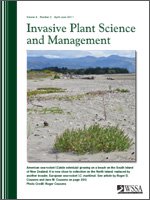Coral ardisia (Ardisia crenata) has been present in Florida for more than 100 yr as an ornamental and has become invasive in hammocks of natural areas. This plant forms dense understory cover, often greater than 90%, which can suppress native plant recruitment and growth. Results from herbicide trials at two sites in Florida indicate that a single foliar treatment applied as a spot application of triclopyr amine, triclopyr ester, glyphosate, imazapic, dicamba, triclopyr amine imazapic, or triclopyr ester fluroxypyr reduced Ardisia crenata to less than 13% at 12 mo after treatment (MAT). A single treatment of imazapic (2.4 g ae L−1) or imazapic (2.4 g ae L−1) triclopyr (10.8 g ae L−1) reduced cover of mature plants to less than 0.5% and seedlings to less than or equal to 4% at 12 MAT. Native plant cover was less than 5% prior to treatment indicating that dense infestations of Ardisia crenata may suppress native vegetation. In the dense infestations of Ardisia crenata observed in this study, nontarget damage was not a concern due to the rarity of native plants. However, applicators should use caution applying triclopyr and imazapic when small shrubs and trees are present in the treatment area. Additional follow-up treatments will be required for control of seedling and possible resprouts at 12 MAT.
Nomenclature: Dicamba; fluroxypyr; glyphosate; imazapic; triclopyr; coral ardisia, Ardisia crenata Sims
Interpretive Summary: Coral ardisia (Ardisia crenata) is an invasive plant of natural areas throughout Florida that forms dense understory cover and suppresses native plants. This plant exhibits the potential to spread throughout all the southernmost states in the United States from North Carolina to California. These results from herbicide trials at two field sites in north-central Florida indicate that a single application of triclopyr, dicamba, imazapic, glyphosate, triclopyr imazapic, ortriclopyr fluroxypyr suppressed mature cover of Ardisia crenata for 12 mo. Seedling cover 12 mo after treatment was highly variable but tended to be very low in treatments containing imazapic. This study indicates that Ardisia crenata is effectively controlled with herbicides, but monitoring and retreatment at 12 mo or less following the initial treatment will be required for further suppression, especially for emerging seedlings. Longer studies are suggested to evaluate the response of native plant recovery following herbicide treatment of Ardisia crenata.





